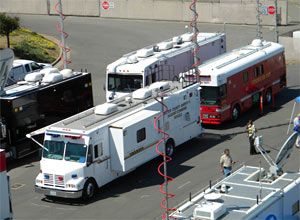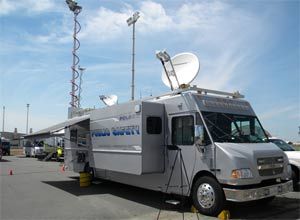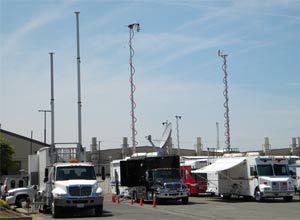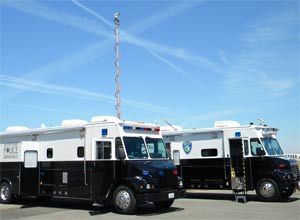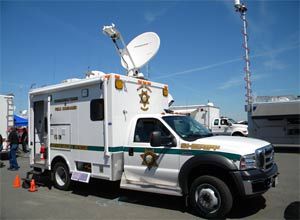The proliferation of command and communications vehicles in local emergency response and emergency management agencies in recent years has brought a wealth of high-tech tools for better managing and coordinating the responses to major emergencies and disasters. Nonetheless, treating these expensive vehicles as isolated units to be deployed only when the Big One hits loses sight of their true innovative potential as interoperability platforms on wheels.
The myriad capabilities of the modern MCC (“Mobile Communications Center” according to NIMS resource typing; see www.fema.gov/pdf/emergency/nims/incident_mgmt.pdf) allows most of these planning and logistical resources to function as standalone interoperability platforms, as well accommodating dozens of other incident command and support functions vital to modern incident management systems. Networked together, a grouping of these resources can serve the needs of a disparate number of responders and response agencies, bringing regionally based command, control and communications capabilities right to the incident site or tactical command post.
Born East, expanding West
It was with that idea that the first series of annual MCC Rallies was initiated in Fairfax County, Va., in 2004. I’d been involved in developing two command/communications vehicles for the San Jose (Calif.) Fire Department and had explored MCCs for some time as I wrote articles about them for public safety and homeland security trade magazines. When I heard about the Virginia rallies, I realized the benefit such an event would have for the West Coast.
Through my involvement with the California Fire Chiefs Association’s Communications Section, and with the support of the California Emergency Management Agency (Cal EMA, then the Governor’s Office of Emergency Services), we held our first MCC Rally in May 2009, attracting 20 state-of-the-art mobile command and communications vehicles and trailers from law enforcement and fire departments, local government, the private sector, and regional and state agencies.
Once again held at the Northern California Regional Public Safety Training Center in Sacramento, our second annual MCC Rally, held on May 12, brought an even more diverse array of mobile communications resources and was enhanced by a concurrent series of classes throughout the day.
The goal of the MCC Rally is, first, to bring a variety of such units to one place so personnel throughout the region can see what resources are available in their given area, get to know each other and understand how to partner with their allied agencies and private-sector responders so that during a real disaster or emergency, they can best integrate each other’s capabilities to maximize command, control and communications in support of the response.
Additionally, by learning from the experiences of others in designing, deploying and operating modern MCCs, attendees come away with ideas that can be used to modify their own MCC operations or designs.
Both public and private
In this year’s rally, we wanted especially to involve more private-sector and vendor participation than we had in 2009, recognizing that true disaster management will require the close cooperation and partnership of each of these sectors in addition to our own network of public safety hierarchies. We invited manufacturers of MCCs and suppliers of wireless and interoperability systems, and they brought out the latest and greatest tools and technology to whet the attendees’ appetites.
In addition to public safety first responders of every discipline, we also had allied support services like the California Dept. of Transportation, California EMS Authority and California Air Resources Board. Meanwhile, private-sector leaders like Cisco, Raytheon and Verizon Wireless displayed their command units, giving many in the response community a close look at what these support organizations can bring to the planning and logistics tables at an incident.
Good things came in both big and small packages. MCC manufacturer LDV was on hand for a show-and-tell of the latest upgrades in their large MCC packages. In-service units from a number of other specialty vehicle companies from around the state were on display, as were a handful of Type 1 and 2 MCCs that had been developed and built in-house. Vendors also shared their expertise and advice in several of the classes offered throughout the day.
Smaller MCCs also were on hand, like San Mateo County’s newly-renovated small van and pickup truck combo and one of the six brand new piggyback Mobile Interoperability Gateway Units from Cal EMA. One such unit is deployed to each of the state’s six mutual aid regions to ensure that interoperable communications resources are available to support major emergency responses.
The rally lasted from 9 a.m. to 4 p.m. and brought a cadre of very interested public safety and emergency management professionals from around the state to tour the MCCs and hear firsthand about their capabilities, while learning about such topics as MCC upgrades and retrofitting, the intricacies of modern interoperability systems, acquisition of satellite communication systems, and tactical field communication operations during the classes and live demonstrations.
More than one vendor participant told me that they found the rally much more valuable to them than even the national trade shows they regularly attend, since here every attendee had a specific interest in the topic of mobile communication centers. Having the vendors on hand also allowed agencies with older MCCs or ready grant funding to discuss upgrades and enhancements face-to-face with manufacturers.
Ideas for next time
The rally’s focus, however, remained not on sales pitches but on operations, with the emphasis on learning to work together, understanding the capabilities and availability of neighboring responders and support agencies, and coming away with an enhanced understanding about the role of the MCC and its staff in incident management. More than one attendee left the rally with a notebook full of ideas on how to operate more efficiently or tweak the designs of their next MCC.
Among the attendees was a fire department representative from Reno, Nev., seeking ideas to inaugurate an MCC Rally in his state. Thus we pay Virginia’s example forward.
Planning for California’s 2011 MCC Rally will begin in a few weeks. Taking another cue from Fairfax County, we hope to coordinate live interoperability exercises between MCCs and other units to provide more hands-on exposure for participants and attendees alike.
Learning what resources are accessible during a disaster response, planning how to coordinate them into a single unified command post, and knowing in advance how to interoperate on every level is the first step in being truly prepared.


